[English] 日本語
 Yorodumi
Yorodumi- EMDB-1669: Cryo-EM structures of the idle yeast Ssh1 complex bound to the ye... -
+ Open data
Open data
- Basic information
Basic information
| Entry | Database: EMDB / ID: EMD-1669 | |||||||||
|---|---|---|---|---|---|---|---|---|---|---|
| Title | Cryo-EM structures of the idle yeast Ssh1 complex bound to the yeast 80S ribosome | |||||||||
 Map data Map data | This map represents a yeast 80S ribosome bound to the idle yeast Ssh1 complex | |||||||||
 Sample Sample |
| |||||||||
 Keywords Keywords | Ribosome / protein exit tunnel / cotranslational protein translocation / protein conducting channel / signal sequence | |||||||||
| Function / homology |  Function and homology information Function and homology information: / translocon complex / Insertion of tail-anchored proteins into the endoplasmic reticulum membrane / cytoplasmic translational elongation / rough endoplasmic reticulum membrane / Ssh1 translocon complex / Sec61 translocon complex / SRP-dependent cotranslational protein targeting to membrane, translocation / signal sequence binding / SRP-dependent cotranslational protein targeting to membrane ...: / translocon complex / Insertion of tail-anchored proteins into the endoplasmic reticulum membrane / cytoplasmic translational elongation / rough endoplasmic reticulum membrane / Ssh1 translocon complex / Sec61 translocon complex / SRP-dependent cotranslational protein targeting to membrane, translocation / signal sequence binding / SRP-dependent cotranslational protein targeting to membrane / post-translational protein targeting to membrane, translocation / regulation of amino acid metabolic process / negative regulation of glucose mediated signaling pathway / positive regulation of translational fidelity / RMTs methylate histone arginines / Protein methylation / nuclear inner membrane / Protein hydroxylation / ribosome-associated ubiquitin-dependent protein catabolic process / pre-mRNA 5'-splice site binding / GDP-dissociation inhibitor activity / positive regulation of nuclear-transcribed mRNA catabolic process, deadenylation-dependent decay / nonfunctional rRNA decay / Formation of the ternary complex, and subsequently, the 43S complex / Translation initiation complex formation / response to cycloheximide / Ribosomal scanning and start codon recognition / cleavage in ITS2 between 5.8S rRNA and LSU-rRNA of tricistronic rRNA transcript (SSU-rRNA, 5.8S rRNA, LSU-rRNA) / preribosome, small subunit precursor / Major pathway of rRNA processing in the nucleolus and cytosol / mRNA destabilization / SRP-dependent cotranslational protein targeting to membrane / GTP hydrolysis and joining of the 60S ribosomal subunit / negative regulation of mRNA splicing, via spliceosome / preribosome, large subunit precursor / Formation of a pool of free 40S subunits / Nonsense Mediated Decay (NMD) independent of the Exon Junction Complex (EJC) / Nonsense Mediated Decay (NMD) enhanced by the Exon Junction Complex (EJC) / negative regulation of translational frameshifting / L13a-mediated translational silencing of Ceruloplasmin expression / endonucleolytic cleavage to generate mature 3'-end of SSU-rRNA from (SSU-rRNA, 5.8S rRNA, LSU-rRNA) / translational elongation / protein transmembrane transporter activity / G-protein alpha-subunit binding / ribosomal large subunit export from nucleus / protein kinase activator activity / 90S preribosome / ribonucleoprotein complex binding / translational termination / regulation of translational fidelity / ribosomal subunit export from nucleus / protein-RNA complex assembly / maturation of LSU-rRNA / endonucleolytic cleavage in ITS1 to separate SSU-rRNA from 5.8S rRNA and LSU-rRNA from tricistronic rRNA transcript (SSU-rRNA, 5.8S rRNA, LSU-rRNA) / translation regulator activity / ribosomal small subunit export from nucleus / DNA-(apurinic or apyrimidinic site) endonuclease activity / rescue of stalled cytosolic ribosome / protein kinase C binding / guanyl-nucleotide exchange factor activity / ribosomal large subunit biogenesis / maturation of LSU-rRNA from tricistronic rRNA transcript (SSU-rRNA, 5.8S rRNA, LSU-rRNA) / maturation of SSU-rRNA from tricistronic rRNA transcript (SSU-rRNA, 5.8S rRNA, LSU-rRNA) / macroautophagy / maturation of SSU-rRNA / small-subunit processome / translational initiation / maintenance of translational fidelity / modification-dependent protein catabolic process / protein tag activity / cytoplasmic stress granule / rRNA processing / large ribosomal subunit / ribosome biogenesis / ribosome binding / ribosomal small subunit biogenesis / ribosomal small subunit assembly / 5S rRNA binding / ribosomal large subunit assembly / small ribosomal subunit / small ribosomal subunit rRNA binding / large ribosomal subunit rRNA binding / cytosolic small ribosomal subunit / cytosolic large ribosomal subunit / cytoplasmic translation / negative regulation of translation / rRNA binding / protein ubiquitination / structural constituent of ribosome / ribosome / translation / G protein-coupled receptor signaling pathway / negative regulation of gene expression / response to antibiotic / mRNA binding / ubiquitin protein ligase binding / endoplasmic reticulum membrane / nucleolus / structural molecule activity / endoplasmic reticulum Similarity search - Function | |||||||||
| Biological species |  | |||||||||
| Method | single particle reconstruction / cryo EM / negative staining / Resolution: 8.8 Å | |||||||||
 Authors Authors | Becker T / Mandon E / Bhushan S / Jarasch A / Armache JP / Funes S / Jossinet F / Gumbart J / Mielke T / Berninghausen O ...Becker T / Mandon E / Bhushan S / Jarasch A / Armache JP / Funes S / Jossinet F / Gumbart J / Mielke T / Berninghausen O / Schulten K / Westhof E / Gilmore R / Beckmann R | |||||||||
 Citation Citation |  Journal: Science / Year: 2009 Journal: Science / Year: 2009Title: Structure of monomeric yeast and mammalian Sec61 complexes interacting with the translating ribosome. Authors: Thomas Becker / Shashi Bhushan / Alexander Jarasch / Jean-Paul Armache / Soledad Funes / Fabrice Jossinet / James Gumbart / Thorsten Mielke / Otto Berninghausen / Klaus Schulten / Eric ...Authors: Thomas Becker / Shashi Bhushan / Alexander Jarasch / Jean-Paul Armache / Soledad Funes / Fabrice Jossinet / James Gumbart / Thorsten Mielke / Otto Berninghausen / Klaus Schulten / Eric Westhof / Reid Gilmore / Elisabet C Mandon / Roland Beckmann /  Abstract: The trimeric Sec61/SecY complex is a protein-conducting channel (PCC) for secretory and membrane proteins. Although Sec complexes can form oligomers, it has been suggested that a single copy may ...The trimeric Sec61/SecY complex is a protein-conducting channel (PCC) for secretory and membrane proteins. Although Sec complexes can form oligomers, it has been suggested that a single copy may serve as an active PCC. We determined subnanometer-resolution cryo-electron microscopy structures of eukaryotic ribosome-Sec61 complexes. In combination with biochemical data, we found that in both idle and active states, the Sec complex is not oligomeric and interacts mainly via two cytoplasmic loops with the universal ribosomal adaptor site. In the active state, the ribosomal tunnel and a central pore of the monomeric PCC were occupied by the nascent chain, contacting loop 6 of the Sec complex. This provides a structural basis for the activity of a solitary Sec complex in cotranslational protein translocation. | |||||||||
| History |
|
- Structure visualization
Structure visualization
| Movie |
 Movie viewer Movie viewer |
|---|---|
| Structure viewer | EM map:  SurfView SurfView Molmil Molmil Jmol/JSmol Jmol/JSmol |
| Supplemental images |
- Downloads & links
Downloads & links
-EMDB archive
| Map data |  emd_1669.map.gz emd_1669.map.gz | 21.5 MB |  EMDB map data format EMDB map data format | |
|---|---|---|---|---|
| Header (meta data) |  emd-1669-v30.xml emd-1669-v30.xml emd-1669.xml emd-1669.xml | 12.4 KB 12.4 KB | Display Display |  EMDB header EMDB header |
| Images |  1669.gif 1669.gif 1669_EMD_1669_inactive_yeast.jpg 1669_EMD_1669_inactive_yeast.jpg | 91.2 KB 220.3 KB | ||
| Archive directory |  http://ftp.pdbj.org/pub/emdb/structures/EMD-1669 http://ftp.pdbj.org/pub/emdb/structures/EMD-1669 ftp://ftp.pdbj.org/pub/emdb/structures/EMD-1669 ftp://ftp.pdbj.org/pub/emdb/structures/EMD-1669 | HTTPS FTP |
-Related structure data
| Related structure data |  2wwaMC  3izdM  4v6iM  1651C  1652C  1667C  1668C  2ww9C  2wwbC M: atomic model generated by this map C: citing same article ( |
|---|---|
| Similar structure data |
- Links
Links
| EMDB pages |  EMDB (EBI/PDBe) / EMDB (EBI/PDBe) /  EMDataResource EMDataResource |
|---|---|
| Related items in Molecule of the Month |
- Map
Map
| File |  Download / File: emd_1669.map.gz / Format: CCP4 / Size: 185.7 MB / Type: IMAGE STORED AS FLOATING POINT NUMBER (4 BYTES) Download / File: emd_1669.map.gz / Format: CCP4 / Size: 185.7 MB / Type: IMAGE STORED AS FLOATING POINT NUMBER (4 BYTES) | ||||||||||||||||||||||||||||||||||||||||||||||||||||||||||||||||||||
|---|---|---|---|---|---|---|---|---|---|---|---|---|---|---|---|---|---|---|---|---|---|---|---|---|---|---|---|---|---|---|---|---|---|---|---|---|---|---|---|---|---|---|---|---|---|---|---|---|---|---|---|---|---|---|---|---|---|---|---|---|---|---|---|---|---|---|---|---|---|
| Annotation | This map represents a yeast 80S ribosome bound to the idle yeast Ssh1 complex | ||||||||||||||||||||||||||||||||||||||||||||||||||||||||||||||||||||
| Projections & slices | Image control
Images are generated by Spider. | ||||||||||||||||||||||||||||||||||||||||||||||||||||||||||||||||||||
| Voxel size | X=Y=Z: 1.2375 Å | ||||||||||||||||||||||||||||||||||||||||||||||||||||||||||||||||||||
| Density |
| ||||||||||||||||||||||||||||||||||||||||||||||||||||||||||||||||||||
| Symmetry | Space group: 1 | ||||||||||||||||||||||||||||||||||||||||||||||||||||||||||||||||||||
| Details | EMDB XML:
CCP4 map header:
| ||||||||||||||||||||||||||||||||||||||||||||||||||||||||||||||||||||
-Supplemental data
- Sample components
Sample components
-Entire : An idle yeast Ssh1 complex bound to a yeast 80S ribosome
| Entire | Name: An idle yeast Ssh1 complex bound to a yeast 80S ribosome |
|---|---|
| Components |
|
-Supramolecule #1000: An idle yeast Ssh1 complex bound to a yeast 80S ribosome
| Supramolecule | Name: An idle yeast Ssh1 complex bound to a yeast 80S ribosome type: sample / ID: 1000 Details: 80S ribosomes and the detergent solubilized Ssh1 complex were reconstituted in vitro by adding 1 pmol of ribosome and Ssh1 complex in 5 fold molar excess Oligomeric state: 80S Ribosome bound to one copy of the heterotrimeric Ssh1 complex Number unique components: 2 |
|---|---|
| Molecular weight | Experimental: 4.2 MDa / Theoretical: 4.2 MDa / Method: Known for 80S ribosomes |
-Supramolecule #1: Yeast 80S ribosome bound to the yeast Ssh1 complex
| Supramolecule | Name: Yeast 80S ribosome bound to the yeast Ssh1 complex / type: complex / ID: 1 Name.synonym: Yeast 80S ribosome bound to the yeast Ssh1 complex Ribosome-details: ribosome-eukaryote: ALL |
|---|---|
| Molecular weight | Experimental: 4.2 MDa / Theoretical: 4.2 MDa |
-Macromolecule #1: Ssh1 complex
| Macromolecule | Name: Ssh1 complex / type: ligand / ID: 1 / Name.synonym: Ssh1 complex / Details: His FLAG-tagged / Number of copies: 1 / Oligomeric state: Heterotrimer / Recombinant expression: Yes |
|---|---|
| Source (natural) | Organism:  |
| Molecular weight | Theoretical: 71.5 KDa |
| Recombinant expression | Organism:  |
-Experimental details
-Structure determination
| Method | negative staining, cryo EM |
|---|---|
 Processing Processing | single particle reconstruction |
| Aggregation state | particle |
- Sample preparation
Sample preparation
| Buffer | pH: 7.5 Details: 20 mM HEPES/KOH, pH 7.5 100 mM KOAc, 10 mM Mg(OAc)2, 1.5 mM DTT, 0.1 % (w/v) digitonin |
|---|---|
| Staining | Type: NEGATIVE / Details: Cryo-EM |
| Grid | Details: Quantifoil grids (3/3) with 2 nm carbon on top |
| Vitrification | Cryogen name: ETHANE / Chamber humidity: 95 % / Instrument: OTHER / Details: Vitrification instrument: Vitrobot Method: Blot for 10 seconds before plunging, use 2 layer of filter paper |
- Electron microscopy
Electron microscopy
| Microscope | FEI POLARA 300 |
|---|---|
| Temperature | Average: 84 K |
| Alignment procedure | Legacy - Astigmatism: Objective lens astigmatism was corrected at 100000 times magnification |
| Image recording | Category: FILM / Film or detector model: KODAK SO-163 FILM / Digitization - Scanner: PRIMESCAN / Digitization - Sampling interval: 4.76 µm / Number real images: 185 / Average electron dose: 25 e/Å2 / Details: Scanned at 5334 dpi / Od range: 1.2 / Bits/pixel: 16 |
| Tilt angle min | 0 |
| Tilt angle max | 0 |
| Electron beam | Acceleration voltage: 300 kV / Electron source:  FIELD EMISSION GUN FIELD EMISSION GUN |
| Electron optics | Calibrated magnification: 38000 / Illumination mode: FLOOD BEAM / Imaging mode: BRIGHT FIELD / Cs: 2.26 mm / Nominal defocus max: 4.5 µm / Nominal defocus min: 1.2 µm / Nominal magnification: 39000 |
| Sample stage | Specimen holder: FEI Polara cartridge system / Specimen holder model: OTHER |
| Experimental equipment |  Model: Tecnai Polara / Image courtesy: FEI Company |
- Image processing
Image processing
| Details | Particles were selected using the program SIGNATURE and visually inspected. This map resulted from sorting against the ES27 exit position and subsequent sorting for tRNA and the Ssh1 complex and represents the datasubset with the Ssh1 complex present without tRNA. |
|---|---|
| CTF correction | Details: Defocus group volumes |
| Final reconstruction | Applied symmetry - Point group: C1 (asymmetric) / Algorithm: OTHER / Resolution.type: BY AUTHOR / Resolution: 8.8 Å / Resolution method: FSC 0.5 CUT-OFF / Software - Name: SPIDER Details: Map was filtered between 8.3 and 10.3 Angstrom to better visualize the Ssh1 complex Number images used: 20400 |
| Final angle assignment | Details: SPIDER |
 Movie
Movie Controller
Controller


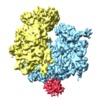
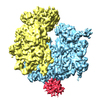




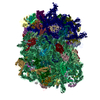
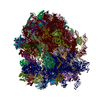

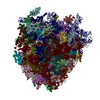













 Z (Sec.)
Z (Sec.) X (Row.)
X (Row.) Y (Col.)
Y (Col.)





















